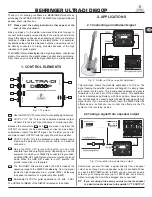
SM320F2812-HT
www.ti.com
SGUS062B
–
JUNE 2009
–
REVISED JUNE 2011
6.6
Reducing Current Consumption
28x DSPs incorporate a unique method to reduce the device current consumption. A reduction in current
consumption can be achieved by turning off the clock to any peripheral module which is not used in a
given application.
Table 6-1
indicates the typical reduction in current consumption achieved by turning off
the clocks to various peripherals.
Table 6-1. Typical Current Consumption by Various Peripherals (at 150 MHz)
(1)
(2)
PERIPHERAL MODULE
I
DD
CURRENT REDUCTION (mA)
eCAN
12
EVA
6
EVB
6
ADC
8
(3)
SCI
4
SPI
5
McBSP
13
(1)
All peripheral clocks are disabled upon reset. Writing to/reading from peripheral registers is
possible only after the peripheral clocks are turned on.
(2)
Not production tested.
(3)
This number represents the current drawn by the digital portion of the ADC module. Turning off the
clock to the ADC module results in the elimination of the current drawn by the analog portion of the
ADC (I
CCA
) as well.
6.7
Power Sequencing Requirements
SM320F2812 silicon requires dual voltages (1.8-V or 1.9-V and 3.3-V) to power up the CPU, Flash, ROM,
ADC, and the I/Os. To ensure the correct reset state for all modules during power up, there are some
requirements to be met while powering up/powering down the device. The current F2812 silicon reference
schematics (Spectrum Digital Incorporated eZdsp. board) suggests two options for the power sequencing
circuit.
•
Option 1: In this approach, an external power sequencing circuit enables V
DDIO
first, then V
DD
and
V
DD1
(1.8 V or 1.9 V). After 1.8 V (or 1.9 V) ramps, the 3.3 V for Flash (V
DD3VFL
) and ADC
(V
DDA1
/V
DDA2
/AV
DDREFBG
) modules are ramped up. While option 1 is still valid, TI has simplified the
requirement. Option 2 is the recommended approach.
•
Option 2: Enable power to all 3.3-V supply pins (V
DDIO
, V
DD3VFL
, V
DDA1
/V
DDA2
/V
DDAIO
/AV
DDREFBG
) and
then ramp 1.8 V (or 1.9 V) (V
DD
/V
DD1
) supply pins. 1.8 V or 1.9 V (V
DD
/V
DD1
) should not reach 0.3 V
until V
DDIO
has reached 2.5 V. This ensures the reset signal from the I/O pin has propagated through
the I/O buffer to provide power-on reset to all the modules inside the device. See
Figure 6-8
for
power-on reset timing.
•
Power-Down Sequencing: During power-down, the device reset should be asserted low (8
μ
s,
minimum) before the V
DD
supply reaches 1.5 V. This helps to keep on-chip flash logic in reset prior to
the V
DDIO
/V
DD
power supplies ramping down. It is recommended that the device reset control from
Low-Dropout (LDO) regulators or voltage supervisors be used to meet this constraint. LDO regulators
that facilitate power-sequencing (with the aid of additional external components) may be used to meet
the power sequencing requirement. See
www.spectrumdigital.com
for F2812 eZdsp
™
schematics and
updates.
Table 6-2. Recommended Low-Dropout Regulators
SUPPLIER
PART NUMBER
Texas Instruments
TPS767D301
Copyright
©
2009
–
2011, Texas Instruments Incorporated
Electrical Specifications
89
Submit Documentation Feedback
Product Folder Link(s):
SM320F2812-HT
Summary of Contents for SM320F2812-HT Data
Page 152: ......
















































